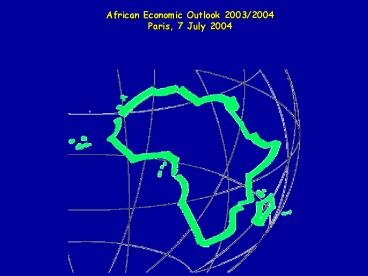AFRICAN ECONOMIC OUTLOOK - PowerPoint PPT Presentation
1 / 35
Title:
AFRICAN ECONOMIC OUTLOOK
Description:
Improvements in the prices of major primary commodities. ... 3.6% of world refining capacity. Supply of motor gasoline. in Nigeria (2001) ... – PowerPoint PPT presentation
Number of Views:58
Avg rating:3.0/5.0
Title: AFRICAN ECONOMIC OUTLOOK
1
African Economic Outlook 2003/2004 Paris, 7 July
2004
2
Background Information
- This is the third issue of the AEO
- A joint project by ADB and OECD Development
Centre - Structure Overview
- Country Notes
- Statistical Annex
3
AEO Challenges
- Making the AEO a reference point for individual
country analysis - Making the AEO an important background document
for the African Peer Review Mechanism - Monitoring progress towards the MDGs
- Improve knowledge on strategic issues for Africa
- Privatization 2002/03
- Energy Sector 2003/04
4
Coverage 22 African countries
North Africa Algeria, Egypt, Morocco and
Tunisia West Africa Burkina Faso, Côte dIvoire,
Ghana, Mali, Nigeria and Senegal Central Africa
Cameroon and Gabon East Africa Ethiopia, Kenya,
Mauritius, Uganda and Tanzania Southern Africa
South Africa, Botswana, Mozambique, Zambia and
Zimbabwe
5
Contents of the Overview
- International Conditions Impacting on Africa
- Macroeconomic performance, 2003 and outlook for
2004/05 - Monetary management
- Fiscal policy
- Progress towards achieving the MDGs
- Governance/Political issues
- This years focus
- Energy Supply in Africa
6
Africa growth in 2003 the highest in 4 years
7
Improved growth performance in 2003 explained by
domestic and external factors
- Internally
- Most African governments continued to follow
prudent macroeconomic policies - Restoration of peace in some parts of Africa,
albeit fragile. - Externally
- Improvements in the prices of major primary
commodities. - Africas exports in value terms increased by some
17 and 4.8 in volume. - Increase in ODA and Debt Relief under HIPCs
8
Total net ODA to Africa jumped by 35 in value
between 2001/02. The upward trend is expected to
continue
9
Inflation in decline
10
Fiscal Deficits Under Control(Percentage of GDP)
11
The MDG on income poverty will not be met on
present trends
12
On present trends most of MDGs will not be
achieved by many countries
13
The satisfactory performance ratio is highest in
the case of equality in primary education
14
Country Highlights
15
Average growth rates of African countries
16
Best and worst performers
17
Western Africa
18
Southern Africa
19
Eastern Africa
20
Fiscal situation of many countriesis still
weakFiscal balance as of GDP, 2003 estimate
21
The impact of high oil prices
- Higher growth in oil exporters
- - Strong fiscal gains
- - First increase in Gabon oil production since
1997 due to vigorous investment in oil sector - More inflation elsewhere
- Burkina Faso (increased transport cost)
- Ethiopia, Zambia in spite of good harvest
22
The impact of the depreciation Rand zone and
CFA zone
23
The impact of the depreciation Rand zone and
CFA zone
- Western Africa was partly shielded from the
depreciation of dollar - Most trade with Euro zone
- Little competitive industry
- Howeverstrong negative fiscal impact
- South Africa in front line fall in
competitiveness but less inflation and moderate
fiscal impact - Other Southern Africa in the shadow of South
Africa Intra regional trade Imported
inflation
24
Agriculture still a matter of vulnerability
- Despite good 2003/04 harvest, East and Southern
Africa continue to suffer - from a structural food crisis
- Food aid needed by
- 5 ml people (39 pop) in Zimbabwe
- 7ml people (10 pop) in Ethiopia
- 1 ml people (3 pop) in Kenya
25
Governance and economic performance
Political tensions
Côte d'Ivoire
Mali
Burkina Faso
Economic performance
Mali
Burkina Faso
Côte d'Ivoire
26
Governance and economic performance
Political tensions and hardening
Zimbabwe Hardening
Zimbabwe Tensions
Regional Average Tensions
Economic performance
Regional Growth
Zimbabwe
27
2003/2004 focus Energy supply in Africa
28
(No Transcript)
29
Huge potential under or badly exploited
- Under-utilisation of potential sources
- Exports rather than national consumption
- Mismanagement of resources
30
Hydroelectric power
31
Oil and NGL, largely exploited 7.3 of world
reserves, 10.6 of world production
32
But mostly exported
3.6 of world refining capacity
Supply of motor gasoline in Nigeria (2001)
33
Gas flaring and shrinkage7.5 of world reserves,
5.5 of world production
34
Energy consumption in Africa (2001)
Coal 7
Gas 16
35
Electrification rates
World average
Developing countries average
36
Challenges for developing the electricity sector
- Serving a scattered, rural population
- Repairing and modernising power facilities
- Extending the network
- Achieving effective, sequenced reforms
- Co-ordinating at regional and continental level
towards integrated power pools
37
Thank you































